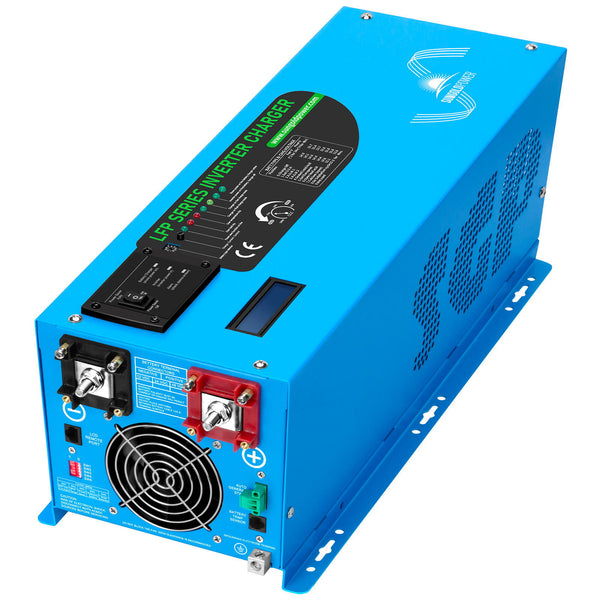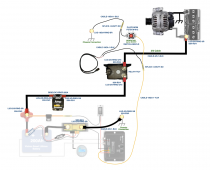. I have a 24v " NOT very SMART" alt. with plenty available power amps. Likely 115amp / 24v available when driving AFTER start/truck batts are charged in daytime (it's a 150amp alt). Since the trucks lighting system is 12v (there is another 50 amp 12v alternator source built in) then even at night much of the 24v alternator's amps is still available. (not very smart= it has some temperature compensation built in... but was not designed with lithium charging in mind)
. have four 12v lead acid making up start/truck batts.
. will have 24v house batts of chemistry type I have not decided.... hence the question in this thread. Weight no so much an issue in using lead acid for this project due to capacity of the truck-camper
. have 500 amp battery isolator to cause start/truck batts to be charged first.... then house batts... but it is NOT SMART except it can jump start truck from house batts.
. will have around 1000 watts of solar.
>>> wanting to charge house batts while driving as quick as possible so can 1) reduce drag on alternator; thus improving mpg on this big CAT engine. 2) use solar to run a hho to improve mpg on this big CAT engine. HHO is worthless in improving mpg when run from alternator.... different story when it is from solar.
ok.... yeah dc to dc..... b2b charger is the common suggestion here if went some other chemistry beside lead acid for "house" batts.... orrrrrrrrrr??? asking "or" cause when you get to 24v and higher everything triples in price. Have you priced dc/dc 24v b2b chargers? and it is STUPID to have 24v/115 available amps for charging but only get to use 20 to 60 of it .... but that seems to be an issue across the board no matter how you try to charge house batts with alternator. Heck I can get a 570amp alternator for my truck... (its military)
anyway could you in an "or" situation; instead of using dc/dc b2b charger... somehow pipe the from the battery isolator the house's charge portion to an inverter charger to top up the house's NOT lead acid batts; such as the one in the link below. Gotta buy an inverter anyway and maybeeee (its close) the inverter charger is less costly when you add it all up, than purchasing an inverter and a dc/dc b2b charger separately

 sungoldpower.com
sungoldpower.com
. have four 12v lead acid making up start/truck batts.
. will have 24v house batts of chemistry type I have not decided.... hence the question in this thread. Weight no so much an issue in using lead acid for this project due to capacity of the truck-camper
. have 500 amp battery isolator to cause start/truck batts to be charged first.... then house batts... but it is NOT SMART except it can jump start truck from house batts.
. will have around 1000 watts of solar.
>>> wanting to charge house batts while driving as quick as possible so can 1) reduce drag on alternator; thus improving mpg on this big CAT engine. 2) use solar to run a hho to improve mpg on this big CAT engine. HHO is worthless in improving mpg when run from alternator.... different story when it is from solar.
ok.... yeah dc to dc..... b2b charger is the common suggestion here if went some other chemistry beside lead acid for "house" batts.... orrrrrrrrrr??? asking "or" cause when you get to 24v and higher everything triples in price. Have you priced dc/dc 24v b2b chargers? and it is STUPID to have 24v/115 available amps for charging but only get to use 20 to 60 of it .... but that seems to be an issue across the board no matter how you try to charge house batts with alternator. Heck I can get a 570amp alternator for my truck... (its military)
anyway could you in an "or" situation; instead of using dc/dc b2b charger... somehow pipe the from the battery isolator the house's charge portion to an inverter charger to top up the house's NOT lead acid batts; such as the one in the link below. Gotta buy an inverter anyway and maybeeee (its close) the inverter charger is less costly when you add it all up, than purchasing an inverter and a dc/dc b2b charger separately

3000W DC 24V Pure Sine Wave Inverter With Charger
Sungoldpower 3000W DC 24V Pure Sine Wave Inverter With Charger. Hightlight: This LFP Series Pure Sine Wave Inverter is a combination of an power inverter 3000w, battery charger and AC auto-transfer switch. GFCI socket, low frequency, low Idle Current, BTS cable, remote control. Adjustable...
Last edited:



